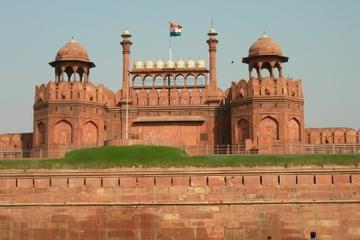
The massive Red Fort (or Lal Qila) stands rather forlornly, a sandstone carcass of its former self. In ages past, when Mughal Emperor Shah Jahan paraded out of the fort atop an elephant into the streets of Old Delhi, he and the fort that he built were a grandiose display of pomp and power. The walls of the fort extend for 1.25 miles (2 kilometers) and vary in height from 60 ft (18 m) on the river side to 110 ft (33 m) on the city side. Shah Jahan began construction of the massive fort in 1638 and it was completed in 1648. Shah Jahan never completely moved his capital from Agra to his new city of Shahjahanabad in Delhi because he was deposed and imprisoned in Agra Fort by his sly son Aurangzeb.
The Red Fort dates from the very peak of Mughal power. Their reign from Delhi was a short one, however; Aurangzeb was the first and last great Mughal emperor to rule from here. The 33 ft (10 m) deep moat, which has been bone-dry since 1857, was originally crossed on creaky wooden drawbridges, but these were replaced with stone bridges in 1811.
Since Independence, many landmark political speeches have taken place at the fort and every year on Independence Day (15 August) it hosts the prime minister's address to the nation. In 2007, the Red Fort was added to UNESCO's World Heritage Site list.
The nearest metro station is Chowri Bazaar or get there by taxi or auto-rickshaw. Each evening (except Monday) a one hour sound-and-light show re-creates events of India's history, particularly those associated with the Red Fort.